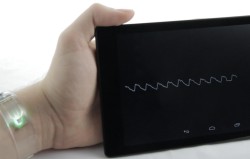Graphene quantum dot detectors for next-generation health monitoring wearables
Health monitoring, especially during exercise, was one of the very first applications allowing smart wearables to graduate from an appealing technological concept to actual, marketable products. However, extended health monitoring to detect all kinds of health markers quickly tends to become bulky. This means that, until now, engineers have had to find the best compromise between functionality and comfort: only a limited number of components could be integrated, making the whole system much less appealing than it could be. A solution, according Dr Frank Koppens from the Spanish Institute of Photonic Sciences (ICFO), lies in the inherent properties of graphene quantum dot (GQD) detectors – photodetectors with characteristics derived from graphene and semi-conducting quantum dots. GQD detectors would indeed enable the development of a flexible, compact and wearable system for constant monitoring of consumer health and muscle health of athletes during exercise or after injury. “Our photodetector is very sensitive to light for a very broad wavelength range, from 300 to 2 200 nm. And most importantly, it is flexible,” stresses Dr Koppens. “This is made possible by the fact that the detector can be placed on basically any flexible substrate. It’s just a few hundred nanometres thick, so it’s excellent for integration into wearable sensors.” The use of graphene is key here, as it provides for an ultra-thin conductor with extremely high conductivity properties, notably electronic mobility. Furthermore, graphene can easily be transferred to flexible substrates and can cover relatively large areas. “It works as follows,” Dr Koppens explains. “Light, be it from a LED device or from the environment, enters the skin, after which it interacts with the tissue and blood vessels. There, it is partially absorbed, but also partially bounces off the skin, in which case it can be picked up by the detector. Now, if the blood veins expand and contract due to heartbeat, the photodetection signal will modulate as well. In other words, the heartbeat is directly visible from the photodetection signal.” This, of course, is just an example. The technology, which was developed under the GRAPHEALTH (Hybrid quantum dot and graphene wearable sensor for systemic haemodynamics and hydration monitoring) project, has demonstrated its capacity to be used for the likes of oxygen monitoring as well. Other important health markers will also soon be detectable. The GRAPHEALTH photodetector is compatible with current flexible electronic manufacturing processes, which means industry should not expect major investment costs. “We have made several prototype wearable devices – including one for the wrist and a patch that is more like a thin sticker – and we have shown that these can be produced with scalable large-area graphene,” enthuses Dr Koppens. Now that the project has come to an end, Dr Koppens and his team intend to make the GRAPHEALTH system more versatile by integrating more health markers. They also want to develop a completely integrated health patch, which would include not only the patch itself but also the electronics, wireless power transfer and wireless data transfer. “It’s difficult to make any predictions regarding potential commercialisation, as flexible electronics and wearables are very young markets. We can create a very large range of different wearables, and integration into existing wearables, such as combining with a smart watch, can also be considered. The challenge now is to make wise choices on which application to focus exactly,” Dr Koppens concludes.
Keywords
GRAPHEALTH, health monitoring, graphene, smart wearables







